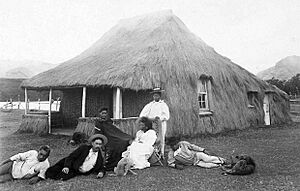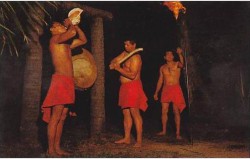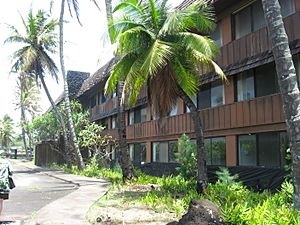Coco Palms Resort facts for kids
The Coco Palms Resort was a famous hotel in Wailuā, Kauaʻi, Hawaiʻi. It was known for its connections to Hollywood movies, beautiful Hawaiian-style weddings, and special torch-lighting ceremonies. The resort was sadly destroyed by a hurricane and has been part of long-standing arguments over land ownership.
The land where Coco Palms sits is very old and important to Native Hawaiians. It was once royal property, meaning it belonged to Hawaiian kings and queens. People have been arguing about who owns this land since 1866.
In 1952, a man named Lyle Guslander leased the land. The Coco Palms Resort opened in early 1953. Grace Buscher, the hotel manager, was very good at making the hotel a popular Hawaiian-style place for tourists. Many movies were filmed there, including Elvis Presley's Blue Hawaii. The hotel became famous for its Hawaiian weddings.
Grace Buscher also started the torch-lighting ceremony, which is still used at hotels across Hawaiʻi today. She also began a tree-planting ceremony to help new coconut trees grow and to honor important people.
Sadly, Hurricane Iniki destroyed Coco Palms in 1992. In 2016, some developers tried to rebuild the resort, but their plans fell apart in 2019.
Contents
A Special Place in History
The Coco Palms Resort is built on a very old and important site. It's located near the mouth of the Wailua River on Kauaʻi. This area is special to Hawaiians because many legends and important historical events happened here. It's believed to be where early voyagers from Kahiki landed around 500 AD.
Royal Connections
In 1810, Kaumualii, the ruler of Kauaʻi, made a peaceful agreement for his island to join Kamehameha I's new Kingdom of Hawaii. Kaumualii was still allowed to rule Kauaʻi.
After Kamehameha I died, his son, Kamehameha II, became the new supreme ruler. Kaumualii's wife, Kekaihaʻakūlou, later known as Deborah Kapule, owned a home near the river. She was known for welcoming travelers, long before any hotels existed. Her home became known as Deborah's Inn. She entertained many visitors there for twenty years.
After Kapule moved away and died, her property fell into disrepair. The land, however, remained important.
The Coconut Grove
The beautiful coconut grove at Coco Palms was not always a royal grove. It was planted in 1896 by William Lindemann, a German immigrant. He hoped to harvest oil and copra (dried coconut meat) from the trees. However, he didn't realize how long it would take for the trees to grow, so his plantation didn't succeed. Today, these large coconut groves along the coast are often called the Coconut Coast.
The Hotel's Story
How Coco Palms Began
In the early 1950s, the site was a small lodge run by an elderly widow. Lyle Guslander, a smart and experienced hotel manager, leased the property in 1952. He didn't have enough money to buy it, but he managed to get a lease from the Territory of Hawaii.
On January 25, 1953, the Coco Palms lodge opened with just 24 rooms. It had five employees and only two guests! The property was 35 acres and had over 2,000 coconut trees. Guslander hired Grace Buscher to help manage the new lodge. She was very creative and understood what tourists wanted.
The hotel was run by a company called Island Holidays Ltd. They quickly started to expand. By 1956, the lodge had grown into a cottage-style hotel with 82 rooms.
Torch Lighting, Movies, and Weddings
The famous torch-lighting ceremony, now seen at many Hawaiian hotels, actually started at Coco Palms thanks to Grace Buscher. It became a big part of the hotel's story. Hawaiians dressed in traditional clothes would blow a conch shell and beat a drum. Then, a man would run across the coconut grove, lighting torches until the whole lagoon was bright. This ceremony was a dramatic call to dinner for guests, sharing bits of Hawaiian culture.
Hollywood quickly became interested in Coco Palms. In May 1953, the movie Miss Sadie Thompson, starring Rita Hayworth, was filmed there. The Chapel in the Palm was built specifically for this movie.
Using this chapel, Grace Buscher created the idea of a Hawaiian wedding for tourists. The song "Hawaiian Wedding Song" became very famous after it was featured in the movie Blue Hawaii, starring Elvis Presley. In the movie, Elvis's character gets married at the lagoon at Coco Palms. The hotel then offered "Blue Hawaii" wedding packages that recreated the movie scene.
Grace Buscher also started the Coco Palms tree-planting ceremony on May 10, 1955. The goal was to plant new trees in the grove and honor important people from Hawaiʻi and around the world. Many famous people had trees planted in their name, including Duke Kahanamoku and Gene Autry.
Hurricane Iniki and Closure
The resort has been closed since Hurricane Iniki hit in 1992. Even though the hotel is closed, tours still visit the grounds. Larry Rivera, a longtime entertainer who worked at the hotel, sometimes shares stories about Elvis and the resort. In 2014, a fire broke out at the resort, but no one was hurt.
Recent Plans and Challenges
New Owners and Land Disputes
In 2013, a company called Coco Palms Hui LLC was formed. Its owners, Chad Waters and Tyler Greene, planned to restore the resort. They estimated it would cost over $100 million to rebuild the hotel and restaurants.
However, the land has a long history of disputes. In 2016, a student named Noa Mau-Espirito began living on a part of the Coco Palms resort. He had researched his family history and found a connection to the land. With others, he started planting traditional plants and caring for ancient burial sites and temples. He believed his family had rights to the land that could not be taken away.
The new owners tried to remove the group, calling them "squatters." But a judge ruled that the ownership of the property had not been fully decided. This situation brought a lot of attention to land issues in Hawaiʻi.
Project Collapse
In March 2019, the plans to rebuild Coco Palms fell apart. The companies that were helping to pay for the project said that the property's loan had not been paid. This meant the land could be taken back by the lenders. The developers said they decided to put the property up for sale again. They hoped a new buyer could move faster to rebuild the resort.
Images for kids







